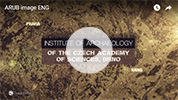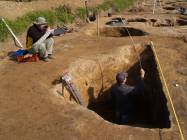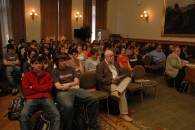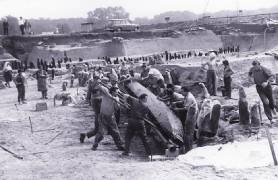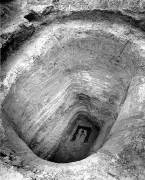Profile
The present-day basic orientation of the establishment is based on the radical transformation undertaken from 1990 - 1995. For this reason the subject of the Institute's main work is basic scientific research performed primarily on the basis of archaeological sources, in the area of prehistoric and early medieval history both in the territory of Moravia and Czech Silesia and in the broader geographical space of the central Danube basin. In its work it specialises on those important sets of archaeological problems which also have, in their given context, a wider (Central) European and also global significance.
These are fundamental questions which can be successfully answered only in the territory under review and in an institution which has at its disposal all the prerequisites, whether this be an extensive base of sources and information, scientific capacity supplemented with supporting activities, the necessary technical equipment as well as a well-established tradition, and which as such cannot be studied in a comparable fashion at other scientific establishments in the Czech Republic. Three basic institution scientific research centres, focused on Palaeolithic Research and Palaeoethnology,Rresearch into Roman History and the Migration Period and finally on Slavonic and Medieval Archaeology are supplemented by departments dealing with selected aspects of Moravian-Silesian prehistory and archaeological prospection.
The study of all the main problem areas under review would not be possible without the work of the Institute's individual research establishments, permanently located directly at long-term archaeological sites or in their immediate vicinity. These research establishments also operate not only as research platforms for individual scientific teams and as a service base for fieldwork, but also as important depositories providing safe keeping for the extensive collections of finds from the Institute's research from the 1950s to the present day. The centre for research into the Palaeolithic and palaeoethnology thus uses a base in Dolní Věstonice, the fieldwork activities of the Centre for the Archaeology of Roman times and the Migration Period have their headquarters for research into Roman military involvement in Dolní Dunajovice - Mušov. The Centre for Slavonic and Early Medieval Archaeology develops its more important activities within a separate facility for research into the Great Moravian period in Mikulčice, which is located directly at the well-know early medieval fortification of Valy. All three of the Institute's research bases have a fifty-year tradition and also contribute significantly to the development of public awareness of the Institute's work in the regions in question.
At the general level, the Institute contributes to improving knowledge and education to the application of scientific results in practice. It obtains, processes and disseminates scientific information, issues scientific publications, journals, proceedings, etc., provides scientific opinions, standpoints and recommendations and conducts consulting and advisory work. In conjunction with universities it implements doctoral work and trains science workers. Within the framework of its activities it develops international cooperation, including the organising of joint research with foreign partners, receiving and sending trainees, exchanging scientific information and preparing joint publications. The Institute arranges international scientific meetings, conferences and seminars. It achieves its goals both independently and in conjunction with universities and other scientific and specialist institutions in both the private and public sectors. The study of individual problem areas is achieved through the broadest possible interdisciplinary and international cooperation, results are published for the most part through its own publishing activities, but also in renowned foreign monographs, journals and proceedings.
From the Institute's history…
The present-day Institute of Archaeology of the Czech Academy of Sciences in Brno has its beginnings in 1942. This much-needed establishment for fundamental archaeological research in Moravia and Czech Silesia was founded in Brno as a subsidiary of the Prague-based State Archaeological Institute. The post of the first Director was nominally filled by the German archaeologist Karl Hucke, but even then the branch was managed in practice by Josef Poulík, under whose guidance - both as an academic and as an influential figure in contemporary science - the institution then developed over the following decades. 1953 brought about a major change, when the Brno subsidiary of the-then State Archaeological Institute was incorporated into the structure of the Czechoslovak Academy of Sciences (ČSAV), then being built up as a successor to the original Czech Academy of Arts and Sciences which had been in existence since 1891. At first it was a branch office of the headquarters Archaeological Institute of the ČSAV in Prague, but in 1970 the Brno location was constituted as an independent ČSAV scientific institute under the title of the Institute of Archaeology of the Czech Academy of Sciences in Brno.
A further, and even more important, turning point came in 1990 and 1993, when the Institute came under new management and a major reorganisation took place. Following the transfer of preservation research mainly over to public administration and local authorities, as well as other organisation measures, the number of staff at the Institute was reduced by more than half. The institution then focused its work entirely on fundamental research. This occurred as part of the newly conceived Czech Academy of Sciences, resulting from the original ČSAV as of 31st December 1992.
A new scientific concept for the Institute of Archaeology of the Czech Academy of Sciences in Brno was prepared and put into practice during 1995. The transition of the Institute as of 1st January 2007 from a state-funded organisation to the category of public research institution within the Czech Academy of Sciences system was a fundamental turning point in the scientific and organisational area. This change within the scope of Act No. 341/2005 Coll. brought with it new legal, economic and organisations requirements and the options for the development of the Institute of Archaeology of the Czech Academy of Sciences, Brno into the 21st century.
Following Academy Member Prof. Josef Poulík, the Institute was led from 1990 - 1998 by Doc. PhDr. Jaroslav Tejral, DrSc., from 1998 - 2017 by Doc PhDr. Pavel, Kouřil, CSc. and since 2017 by PhDr. Lumír Poláček, CSc.
Since its establishment the Institute has contributed in a major fashion to the most important field research in sites for in particular the early Stone Age and the early Middle Ages. As early as the 1950s the unique discoveries at the dwellings of the early Stone Age mammoth hunters under the Pavlov hills in southern Moravia (Dolní Věstonice, Pavlov) became world famous. A genuine breakthrough in the history of the archaeology of the early Middle Ages in the Czech lands and the whole of Central Europe was in 1954, when the Institute began systematic research of a fort in Mikulčice from the period of Great Moravia.
But other systematic archaeological discoveries were also of great scientific benefit. The following are worthy of mention: the later Stone Age settlement in Mohelnice, Bronze Age settlements and burial sites in Lovčičky, Moravičany and Oblekovice, the Celtic fortification at Staré Hradisko near Prostějov, the Roman military fort at Hradisko near Mušov and other Slav forts from the 8th to the 12th centuries (Chotěbuz – Podobora, Staré Zámky u Líšně, Vysoká Zahrada u Dolních Věstonic, Zelená Hora u Vyškova). Of the less-mentioned activities in the field of the archaeology of the High and Later Middle Ages, wide-ranging recognition was achieved by research into two castles from the 14th and the start of the 15th century: Rokštejn u Brtnice and Lelekovice u Brna.
Existing knowledge of the earliest history of Moravia was also substantially broadened by research undertaken by the Institute particularly in the 1980s and 1990s. Of note are a number of activities related to the construction of the Nové Mlýny reservoir in southern Moravia, research during the building of motorways in Moravia and the expansion of archaeology in historical town centres.


